You’ll need to match your miniature scale to your gaming system’s requirements and available space. 28mm scale works perfectly for Warhammer 40,000 and detailed role-playing games, offering intricate character models. 15mm scale suits historical wargames like Flames of War, providing excellent detail while allowing larger battles. 6mm scale enables massive army representations and epic battlefield scenarios. Your choice impacts game mechanics, table space requirements, and detail levels. The following guide reveals how each scale transforms your gaming experience.
Understanding Scale Ratios in Miniature Gaming
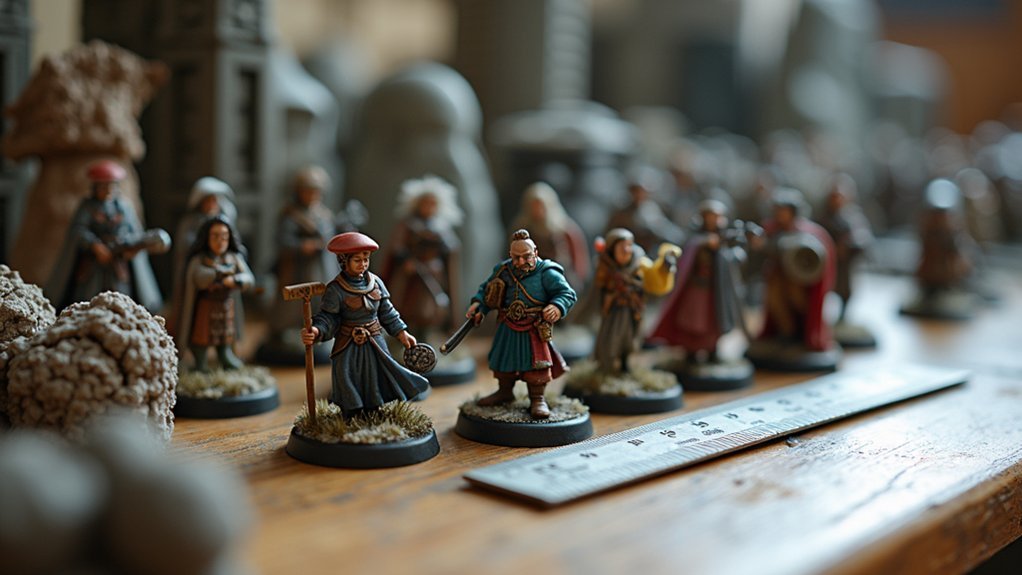
Three primary scale ratios dominate miniature gaming, each offering distinct advantages for different gaming experiences.
In 28mm scale, you’ll find miniatures measuring approximately 28mm from base to eyes, perfect for detailed tabletop games like Warhammer and Dungeons & Dragons.
The 15mm scale offers figures roughly half that height, enabling larger battles with more units on your table—ideal for games like Flames of War.
At 6mm scale, you’re looking at epic-scale gaming where miniatures stand around 6mm tall, allowing massive battlefield representations with extensive unit numbers.
When selecting your scale, consider how game mechanics interact with table space and desired detail levels.
Each scale presents unique advantages and challenges that’ll directly impact your gameplay experience and strategic possibilities.
Popular Gaming Systems and Their Standard Scales
When you’re choosing a gaming system for miniature wargaming, you’ll discover that most established franchises have standardized around specific scales that define their entire ecosystem.
Unlike video games that adapt resolution based on hardware capabilities, tabletop gaming systems maintain consistent physical scales across their product lines.
Popular miniature gaming systems typically use these standard scales:
- 28mm – Warhammer 40,000, Age of Sigmar, and most role-playing miniatures
- 15mm – Flames of War, Team Yankee, and many historical wargames
- 6mm – Epic scale games and large battle simulations
- 1:72 scale – Historical miniatures and plastic model compatibility
It’s important to note that while Video Games can dynamically adjust visual presentation, physical miniatures require you to commit to one scale per game system.
This makes your initial choice essential for long-term compatibility.
28mm Heroic Scale for Warhammer and Fantasy Games
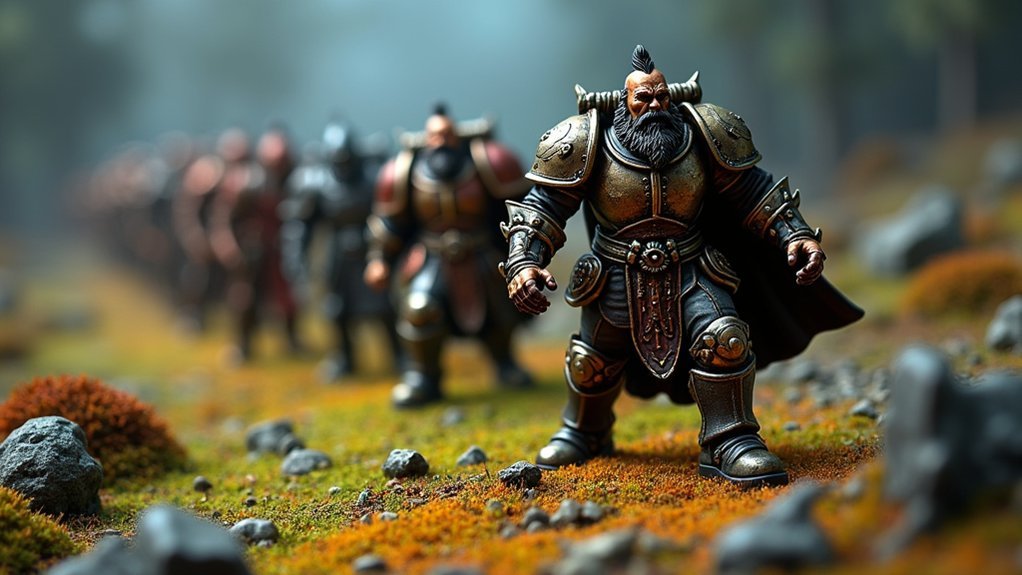
When you’re building armies in Warhammer or fantasy games, you’ll need to understand how mm Heroic Scale affects your model compatibility across different manufacturers and product lines.
Your terrain pieces must match the proportional expectations of 28-32mm models to create believable gaming environments that don’t look oversized or underwhelming.
You’ll also want to reflect on how this scale impacts your army’s visual presence on the table, since larger heroic proportions can make smaller unit counts appear more substantial than traditional scales.
Model Compatibility Standards
Although you’ll find miniatures marketed under various scale designations, the 28mm Heroic Scale has emerged as the dominant standard for Warhammer and most fantasy tabletop games. This standardization creates seamless compatibility across different manufacturers and gaming systems.
When selecting miniatures, you should understand these compatibility standards:
- Universal Scale Recognition – The 1:56 scale ratio guarantees consistent proportions across different faction armies.
- Cross-Manufacturer Compatibility – Most fantasy miniature producers adhere to this standard, allowing you to mix figures freely.
- Enhanced Detail Visibility – Exaggerated proportions make painting details and gameplay identification easier during matches.
- Video Game Translation – Many digital adaptations maintain these proportional standards for visual consistency.
You’ll want to make certain you verify specific measurements when purchasing from newer manufacturers, as slight variations can affect your army’s visual coherence and compatibility.
Terrain Proportions Accuracy
Terrain proportions in 28mm Heroic Scale require precise mathematical relationships to maintain visual authenticity on your gaming table. You’ll need to follow the 1:56 scale conversion where buildings should measure at least 56mm tall for single-story structures. Gaming magazines often recommend using the 28mm-equals-1-foot conversion factor for accurate scaling across x and y dimensions.
| Structure Type | Real Height | 28mm Scale Height |
|---|---|---|
| Single Story Building | 10 feet | 280mm |
| Two Story Building | 20 feet | 560mm |
| Tower/Castle Wall | 30 feet | 840mm |
| Large Monument | 50 feet | 1400mm |
Please check your terrain measurements against your miniature bases to ascertain proper fit. Your 28mm figures representing 6-foot humans should move naturally through doorways and around obstacles without appearing oversized or cramped within the environment.
Army Size Considerations
Since heroic scale miniatures in Warhammer and fantasy games feature exaggerated proportions and striking visual details, you’ll need to plan your army composition around both aesthetic impact and practical table space.
When building your heroic scale army, consider these key factors:
- Base sizing standards – Standard infantry uses 25mm or 32mm round bases, while larger models require appropriately sized bases to accommodate their heroic proportions.
- Unit coherency requirements – Plan spacing between models to maintain game rules while showcasing dynamic poses and intricate designs.
- Table footprint management – Account for the visual bulk that exaggerated heroic scale creates compared to realistic scales.
- Storage and transport needs – Heroic scale’s enhanced details and poses often require specialized foam or magnetic solutions.
Your army’s visual impact depends on balancing unit density with the enhanced aesthetics that define heroic scale gaming.
15mm Scale for Historical Wargaming
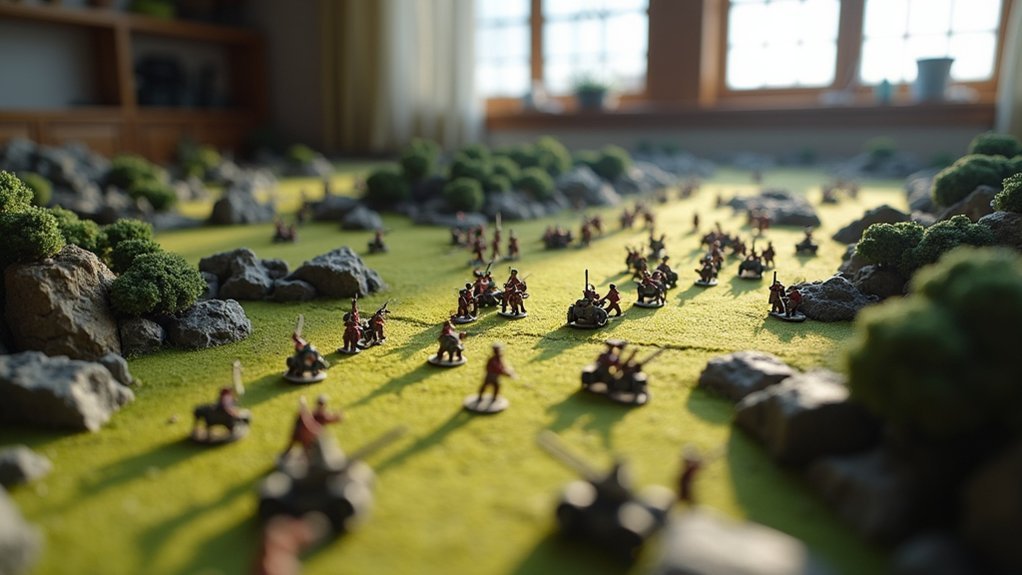
Three primary mm scales dominate historical wargaming: 15mm, 28mm, and 1/72 scale.
You’ll find 28mm offers the best balance between detail and playability, making it the most popular choice among gamers. If you’re working with limited table space or want to field massive armies, 15mm’s smaller units let you recreate grand battles without requiring enormous playing areas.
The 1/72 scale provides excellent value through plastic models, with infantry averaging 20-25mm height. This scale gives you detailed figures while maintaining reasonable space requirements.
Your scale choice directly impacts historical accuracy and battlefield dynamics.
Consider your preferred game type, desired detail level, and available space when deciding. Each scale represents different warfare periods and styles, fundamentally affecting how your units interact and battles unfold.
6mm Scale for Epic Battles and Large Armies
When you’re planning epic battles with massive armies, 28mm scale emerges as the ideal choice for balancing visual impact with practical gameplay. This scale allows you to field vast armies while maintaining excellent detail and unit differentiation during complex maneuvers.
The 28mm scale offers several advantages for large-scale warfare:
- Figure representation – Each miniature represents approximately 6 feet of real-world height, providing realistic proportions.
- Base compatibility – Standard 1-inch (25mm) bases work seamlessly with terrain and gaming boards.
- System integration – Popular wargaming systems like Warhammer 40,000 utilize this scale for maximum compatibility.
- Army management – You can deploy extensive forces without overwhelming your gaming space.
While larger scales like 32mm or 54mm provide more visual drama, they’ll quickly consume your table space when commanding hundreds of troops.
N Scale and Z Scale for Railroad Gaming Integration
When you’re integrating model railroads into your gaming setup, you’ll need to evaluate whether N Scale (1:160) or Z Scale (1:220) best matches your available space and desired detail level.
You must consider how much room you can dedicate to track layouts, as N Scale requires more physical space but offers greater detail options, while Z Scale maximizes complex designs in minimal areas.
Your choice will determine which digital control systems and gaming interfaces you can implement for automated train operations and interactive gameplay elements.
Scale Compatibility Considerations
Although N Scale (1:160) and Z Scale (1:220) both excel at maximizing detail within compact spaces, you’ll face distinct compatibility challenges when integrating these scales into your railroad gaming setup.
When planning your integration, consider these key compatibility factors:
- Scale mixing limitations – You can’t effectively combine N and Z scales in the same layout due to their different proportions and track gauges (9mm vs 6.5mm).
- Gaming piece proportions – Standard gaming accessories may appear oversized next to Z scale models, requiring specialized miniature components.
- Tool requirements – Z scale demands precision instruments for assembly and maintenance, while N scale works with standard modeling tools.
- Aesthetic consistency – Maintaining visual harmony becomes challenging when incorporating larger gaming elements with smaller railroad scales.
Choose one scale and stick with it for best results.
Space Requirements Planning
Three fundamental space calculations determine your success when planning railroad gaming layouts in N or Z scale.
First, measure your available floor or table space, then multiply by your chosen scale factor to determine your maximum layout footprint. N Scale’s 1:160 ratio allows you to fit substantial railroad networks in modest areas, while Z Scale’s 1:220 ratio maximizes your layout potential in extremely limited spaces.
Second, calculate vertical clearance for multi-level designs and operator access. You’ll need adequate room for scenery height and comfortable viewing angles during gameplay.
Third, factor in storage requirements for rolling stock, accessories, and gaming materials. Z Scale’s compact components demand organized storage solutions, while N Scale offers easier handling but requires proportionally more space for equipment organization.
Gaming Integration Methods
Since you’ve established your space requirements, you’ll need to select integration methods that seamlessly blend your N or Z scale railroad with gaming mechanics.
Digital control systems offer the most sophisticated approach, enabling precise movement and scenery control that responds to gameplay events. You can synchronize train movements with game actions, creating dynamic storytelling opportunities.
Consider these integration approaches:
- Digital Command Control (DCC) – Program automated sequences that trigger during specific game scenarios
- Computer-controlled switching – Connect track switches to gaming software for real-time layout changes
- LED lighting systems – Sync building and landscape lighting with game events and day/night cycles
- Sound integration – Coordinate ambient railroad sounds with gameplay audio for immersive experiences
Choose methods matching your technical comfort level and desired interactivity depth.
3D Printer Limitations and Scale Considerations
When you’re planning to print gaming accessories and miniatures, your 3D printer’s build volume becomes the primary constraint that’ll dictate what you can create in a single print job.
Most consumer printers offer build volumes ranging from 200x200x200 mm to over 300x300x400 mm, limiting larger terrain pieces or oversized miniatures.
You’ll notice that scaling affects print quality considerably. Smaller scales deliver finer details, while larger prints may lose precision and clarity.
As you increase scale, expect longer print times and higher material consumption since larger models demand more filament.
Consider your printer’s limitations carefully—warping and poor layer adhesion become problematic with larger prints.
Match your scale choices to your printer’s capabilities, material properties, and your gaming needs for ideal results.
Resin Vs FDM Printing for Different Scales
When you’re choosing between resin and FDM printing for your gaming models, you’ll face a clear trade-off between detail quality and scale capacity.
Resin printers excel at capturing intricate details on smaller miniatures with layer heights as fine as 0.01mm, while FDM printers can handle larger terrain pieces and vehicles but sacrifice fine detail resolution.
Your project’s scale will largely determine which technology suits your needs better – resin for detailed character models under 6 inches, and FDM for expansive terrain and large-scale pieces.
Detail Resolution Comparison
Two fundamentally different 3D printing technologies offer distinct advantages when creating gaming components at various scales.
When you’re choosing between resin and FDM printing, resolution becomes the deciding factor for your project’s success.
FDM printers typically achieve layer heights between 100-300 microns, making them suitable for larger gaming pieces where structural integrity matters more than fine details.
Resin printers excel with layer heights as fine as 25 microns, delivering exceptional detail for miniatures and small accessories.
Consider these resolution differences:
- FDM: Best for components larger than 2 inches with functional requirements
- Resin: Ideal for intricate details under 1 inch requiring smooth finishes
- Layer visibility: More apparent in FDM prints, nearly invisible in resin
- Surface quality: FDM shows layer lines, resin produces smooth surfaces
Your scale choice directly impacts which technology delivers the best results.
Scale Size Limitations
Build volume constraints create hard limits for what you can actually produce with each printing technology.
Resin printers typically max out around 22 cm in height, restricting your ability to create larger gaming system components in single pieces. This limitation forces you to design smaller models or break larger ones into multiple parts for assembly.
FDM printers offer considerably larger build volumes, letting you tackle ambitious projects like full-scale gaming system replicas or terrain pieces.
You’ll find FDM excels at scales from 1:10 to 1:100, while resin works best below 1:35 scale.
When planning your gaming system, consider whether you need room-filling centerpieces or table-top miniatures.
Your scale choice directly impacts which printing technology will actually accommodate your vision.
Layer Height Settings for Optimal Detail
Since layer height directly controls the resolution of your 3D prints, you’ll need to choose the right setting to achieve the detail level your gaming system components require.
Layer height is the key variable that determines whether your 3D printed gaming components will have crisp detail or rough surfaces.
For most gaming pieces, 0.2mm layer height provides an excellent balance between print speed and quality.
However, your specific needs might demand different settings:
- Fine detail work (0.05-0.1mm): Character miniatures, intricate terrain features, and detailed architectural elements
- General purpose (0.2mm): Dice towers, storage boxes, game boards, and standard terrain pieces
- Draft quality (0.3mm+): Quick prototypes, basic terrain, and components where speed matters more than detail
- Test prints: Always run small samples at different heights to determine ideal settings for each component type
Experimenting with these settings helps you find the sweet spot between quality and efficiency.
Scaling Models Up and Down in Slicer Software
Whether you’re creating oversized boss miniatures or shrinking terrain to fit smaller game boards, scaling models in your slicer software gives you complete control over final print dimensions. You’ll find percentage scaling and predefined size settings in most slicers, making adjustments straightforward.
| Scale Factor | Boss Miniature | Terrain Piece |
|---|---|---|
| 50% | Pocket-sized terror | Compact dungeon |
| 100% | Standard intimidation | Perfect tabletop fit |
| 200% | Towering nightmare | Epic battlefield |
Always lock your aspect ratio to prevent distortion that ruins proportions. Use uniform scaling across all axes for consistent results. Remember to adjust print resolution and layer height for larger models—they’ll need different settings to maintain quality. Preview your sliced model before printing to catch any unexpected changes that could affect printability.
Support Structures for Small Scale Miniatures
When you’re printing small scale miniatures, you’ll need robust support structures that won’t compromise the delicate details that make these figures shine.
Your choice of support material and placement strategy directly impacts both print quality and post-processing time, so you’ll want to select materials that remove cleanly without damaging thin weapons or intricate armor details.
Mastering proper assembly techniques guarantees your supports provide adequate reinforcement during printing while allowing for smooth removal that preserves the miniature’s fine features.
Structural Integrity Methods
Though small-scale miniatures may appear delicate, you’ll find that proper structural integrity methods can transform fragile models into durable gaming pieces that withstand countless tabletop sessions.
When designing your miniatures, you’ll want to take into account these essential structural integrity approaches:
- Material selection – Choose resin, plastic, or metal based on your durability requirements and intended use.
- Internal reinforcement – Add bracing components and thicker bases to boost load-bearing capacity.
- Lightweight frameworks – Implement hollow or lattice structures that maintain strength while reducing weight.
- CAD-based testing – Utilize software simulations to analyze stress distribution before production.
You should test prototypes under various stress conditions to identify failure points early.
This process guarantees your final miniature designs remain robust and reliable throughout extended gaming sessions.
Material Selection Guide
Since support structures form the backbone of successful small-scale miniature production, your material choices directly impact both the printing process and final model quality.
You’ll find PLA ideal for beginners due to its ease of printing and excellent strength-to-weight ratio. If you’re creating miniatures for high-temperature environments or need extra durability, ABS offers superior heat resistance and toughness.
For exceptional detail and smooth surface finishes, resin delivers outstanding results, though you’ll need proper ventilation and safety equipment during handling.
When working with larger or complex designs requiring maximum stability, metal supports like brass or steel provide unmatched strength, albeit with increased weight.
For quick prototyping or temporary applications, lightweight foam and cardboard offer cost-effective, easily adjustable solutions that won’t strain your budget.
Assembly Technique Tips
Proper assembly techniques transform your small-scale miniature printing from frustrating trial-and-error into predictable success. Support structures serve as your safety net, preventing warping while preserving intricate details that make miniatures exceptional.
Strategic support placement requires careful consideration of your miniature’s geometry and final appearance.
You’ll want to:
- Position supports away from visible surfaces and fine details to minimize cleanup requirements
- Adjust support density and placement using customizable slicer software settings
- Angle your miniature to reduce overhangs and maintain stability throughout printing
- Experiment with water-soluble support materials for easier removal and superior surface finish
Smart support strategies guarantee your investment in quality materials pays off.
When you balance structural necessity with aesthetic preservation, you’ll consistently produce miniatures that meet professional standards without excessive post-processing work.
Post-Processing Techniques by Scale Size
How dramatically can post-processing techniques transform your gaming visuals when paired with higher resolution scaling?
You’ll discover that anti-aliasing becomes considerably more effective at higher internal resolutions. TAA and FXAA leverage additional pixel data to eliminate jagged edges and enhance visual fidelity dramatically.
Higher resolution scales improve your texture filtering methods, delivering crisper details when downsampled to your monitor’s native resolution.
You’ll notice motion blur and depth of field effects appear more refined and realistic when rendered at elevated internal resolutions.
Your bloom and HDR effects also benefit greatly from resolution scaling. The increased pixel data provides greater detail in lighting and shading variations throughout your scenes, creating more immersive visual experiences that truly showcase your gaming system’s capabilities.
Cost Analysis of Different Scale Productions
When budgeting for gaming scale productions, you’ll find that hardware costs vary dramatically based on your performance expectations and feature requirements.
Your investment directly correlates with the quality and features you’ll receive.
Consider these primary price tiers:
- Budget options ($100 or less): DIY GBS Control units offer basic signal improvement for cost-conscious gamers.
- Mid-range scalers ($100-$150): RetroTINK 2x Pro delivers excellent performance with minimal lag for most retro systems.
- Premium choices ($150-$200): Open Source Scan Converter (OSSC) provides 1080p upscaling with low latency for serious enthusiasts.
- High-end solutions ($300+): RetroTINK 5x offers extensive compatibility and advanced features for discerning collectors.
Like classic car restoration, you’ll want to match your scaler investment to your gaming priorities and budget constraints.
Storage and Organization Solutions by Scale
As your gaming collection expands, you’ll need storage solutions that can adapt to its growing scale and complexity. Small collections work well with compact shelving units that maximize vertical space without overwhelming your room.
As you acquire more titles, consider multi-tiered racks that accommodate different console sizes and game formats. Organize your games by genre or platform to streamline access and enhance your gaming experience. You’ll find titles faster when they’re logically grouped.
Use clear bins and labeled containers for accessories like controllers, cables, and memory cards—this keeps peripherals identifiable and accessible.
Don’t forget digital storage solutions. External hard drives and cloud services are essential for managing downloadable game libraries. Regularly assess your collection, removing unplayed titles to optimize available space.
Frequently Asked Questions
Which Scaling Is Best for Gaming?
You’ll find DLSS or FSR offer the best gaming scaling, providing superior performance while maintaining visual quality. If you’re using older hardware, experiment with traditional resolution scaling to balance frame rates with image clarity.
Does Scaling Affect Gaming?
Yes, scaling directly affects your gaming performance. Higher scaling increases GPU workload, reducing frame rates, while lower scaling improves performance. You’ll notice significant impacts on demanding games, especially with less powerful hardware.
What Is 1920X1080 Scaled Up?
When you scale up 1920×1080, you’re rendering at higher resolutions like 1440p or 4K before downsampling. This creates sharper images with better anti-aliasing, but you’ll need more GPU power.
What Is Scale in Gaming?
Scale in gaming lets you adjust your game’s internal rendering resolution independently from your monitor’s native resolution. You can increase it above 100% for better visuals or decrease it for improved performance.

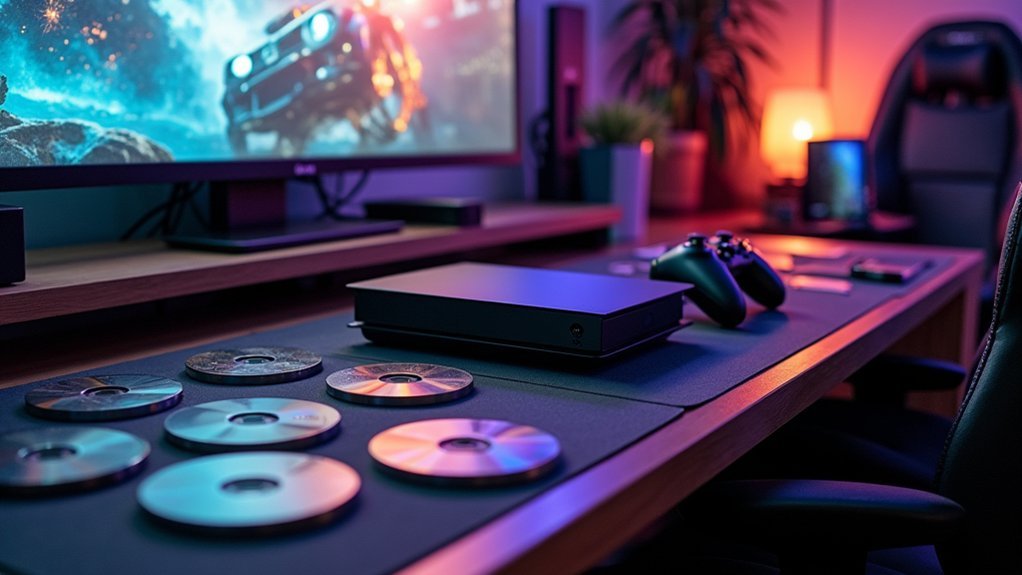
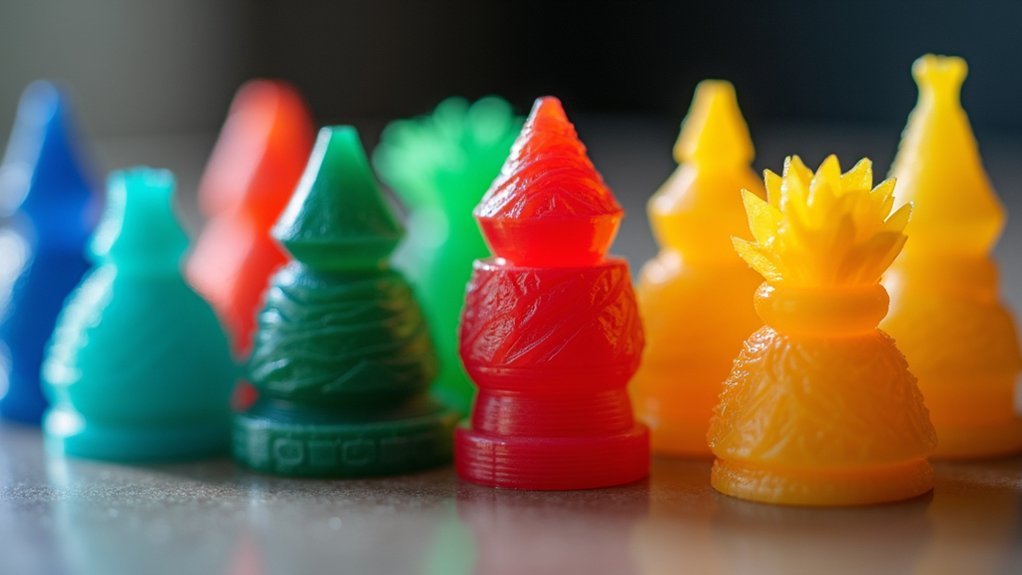
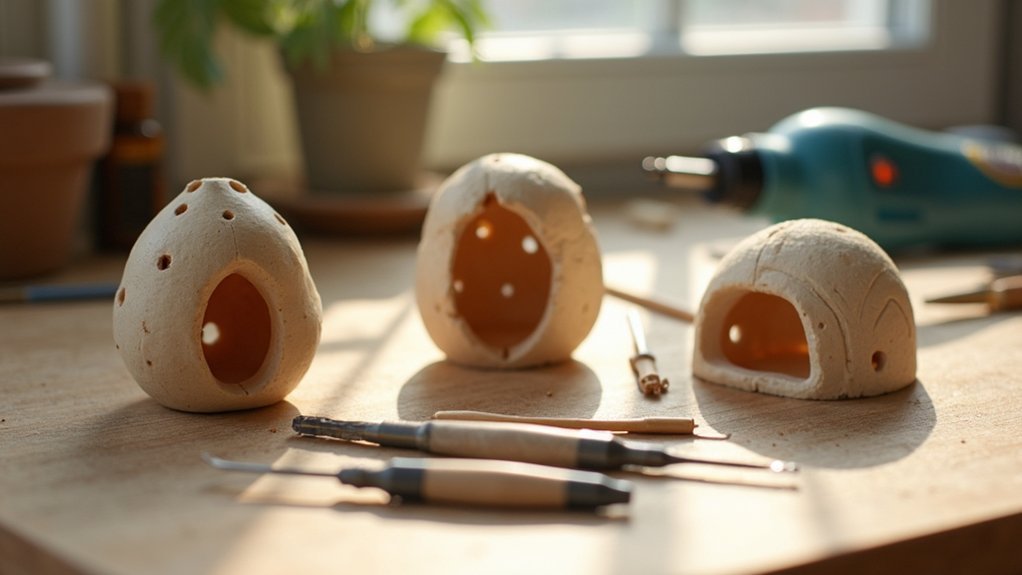
Leave a Reply